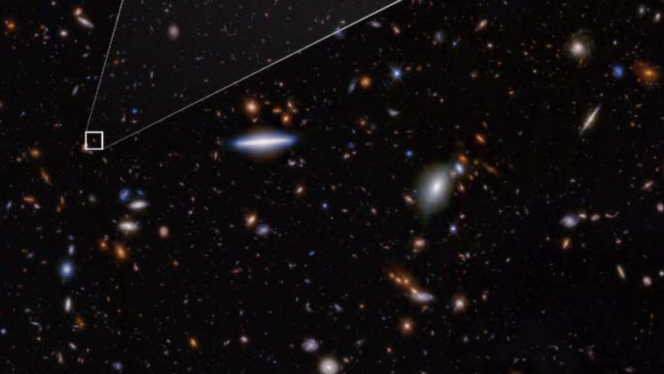
The most powerful space telescope ever built has peered into the dawn of time.
You read that right. The James Webb Space Telescope — with a giant mirror that catches extremely faint light, along with its ability to view a type of light (infrared) that can pass through huge clouds of cosmic gas — has allowed astronomers to spot the earliest galaxy ever found (so far, that is). It formed just 290 million years after the Big Bang, before our galaxy even formed. Our universe is some 13.7 billion years old.
For humanity to be able to view this extremely distant galaxy, dubbed JADES-GS-z14-0, means it’s profoundly bright. (The galaxy’s name is derived from one of Webb’s many ongoing science missions, called the “JWST Advanced Deep Extragalactic Survey (JADES) program.)
“This discovery was not just a new distance record for our team; the most important aspect of JADES-GS-z14-0 was that at this distance, we know that this galaxy must be intrinsically very luminous,” the astronomers Stefano Carniani from Scuola Normale Superiore in Italy, and Kevin Hainline from the University of Arizona, explained in a statement.
The galaxy “shattered” the previous record, they added, which formed some 350 million years after the Big Bang.
The image below, a deep field view into the universe, is filled almost completely with galaxies, many of which are spirals like our Milky Way. The only non-galactic objects are the six-pointed bright spots, which are foreground stars. The record-breaking galaxy, beyond the much closer and clearer galaxies, is that reddish blob.
The galaxy is red because as the universe has incessantly expanded over billions of years, its light has stretched, somewhat like taffy. Longer wavelengths of light are red. (In contrast, blue wavelengths are a much shorter length of visible light.)

Credit: NASA / ESA / CSA / STSc / B. Robertson (UC Santa Cruz) / B. Johnson (CfA) / S. Tacchella (Cambridge) / P. Cargile (CfA)
Scientists used a highly specialized instrument on the Webb telescope, called the Near-Infrared Spectrograph, or NIRSpec, to determine the age of this distant galaxy. A spectrometer acts a bit like a prism, separating light into different colors or parts, ultimately allowing astronomers to dissect the physical properties and composition of the object they’re viewing, like a galaxy or planet. In this case, researchers looked for specific patterns in the light caused by the extreme redshift, allowing them to confirm how old the light is — and thus, how old such a galaxy is.
For being well over 13 billion light-years away (a light-year is nearly 6 trillion miles), JADES-GS-z14-0 is unexpectedly radiant. That leaves the astronomers reaching into the dawn of time with a weighty question:
“This much starlight implies that the galaxy is several hundreds of millions of times the mass of the sun!” the researchers wrote. “This raises the question: How can nature make such a bright, massive, and large galaxy in less than 300 million years?”
The Webb telescope’s powerful abilities
The Webb telescope — a scientific collaboration between NASA, ESA, and the Canadian Space Agency — is designed to peer into the deepest cosmos and reveal new insights about the early universe. But it’s also peering at intriguing planets in our galaxy, along with the planets and moons in our solar system.
Here’s how Webb is achieving unparalleled feats, and likely will for decades:
– Giant mirror: Webb’s mirror, which captures light, is over 21 feet across. That’s over two-and-a-half times larger than the Hubble Space Telescope’s mirror. Capturing more light allows Webb to see more distant, ancient objects. As described above, the telescope is peering at stars and galaxies that formed over 13 billion years ago, just a few hundred million years after the Big Bang.
“We’re going to see the very first stars and galaxies that ever formed,” Jean Creighton, an astronomer and the director of the Manfred Olson Planetarium at the University of Wisconsin–Milwaukee, told Mashable in 2021.
– Infrared view: Unlike Hubble, which largely views light that’s visible to us, Webb is primarily an infrared telescope, meaning it views light in the infrared spectrum. This allows us to see far more of the universe. Infrared has longer wavelengths than visible light, so the light waves more efficiently slip through cosmic clouds; the light doesn’t as often collide with and get scattered by these densely packed particles. Ultimately, Webb’s infrared eyesight can penetrate places Hubble can’t.
“It lifts the veil,” said Creighton.
– Peering into distant exoplanets: As noted above, the Webb telescope carries specialized equipment called spectrographs that will revolutionize our understanding of these far-off worlds. The instruments can decipher what molecules (such as water, carbon dioxide, and methane) exist in the atmospheres of distant exoplanets — be they gas giants or smaller rocky worlds. Webb will look at exoplanets in the Milky Way galaxy. Who knows what we’ll find?
“We might learn things we never thought about,” Mercedes López-Morales, an exoplanet researcher and astrophysicist at the Center for Astrophysics-Harvard & Smithsonian, told Mashable in 2021.
Already, astronomers have successfully found intriguing chemical reactions on a planet 700 light-years away, and as described above, the observatory has started looking at one of the most anticipated places in the cosmos: the rocky, Earth-sized planets of the TRAPPIST solar system.
https://mashable.com/article/james-webb-space-telescope-oldest-galaxy



